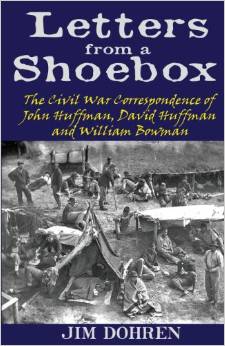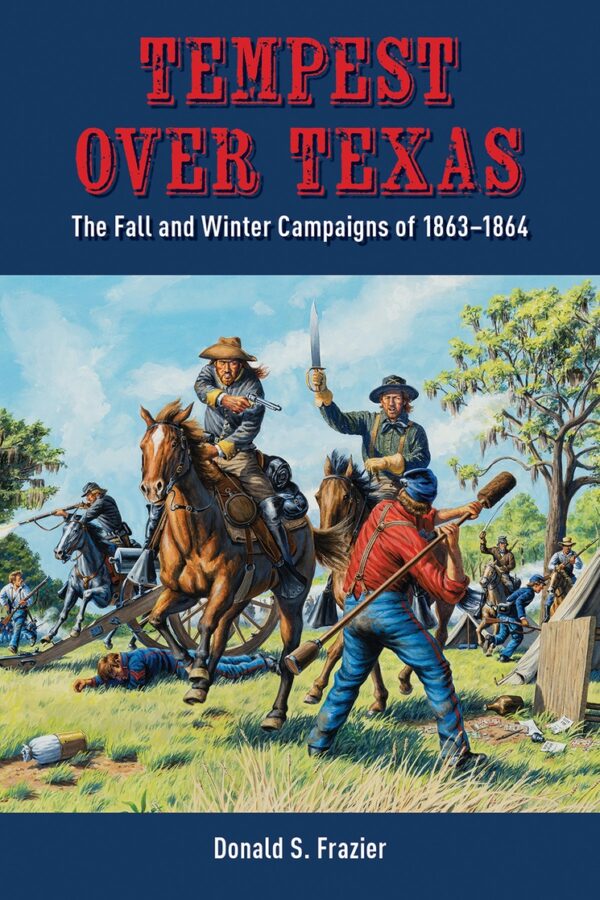Letters from a Shoebox: The Civil War Correspondence of John Huffman, David Huffman and William Bowman edited by Jim Dohren. Sunbury Press, 2013. Paper, ISBN: 978-1620062944. $14.95.
 Civil War historians frequently consult volumes of edited letters hoping to unearthing nuggets of research gold, usually for the sake of enhancing battle narratives, unit histories, or, for academic historians, studies of soldier motivation or “identity.” As a result, researchers can become so focused on the small details they want to find that they lose sight of the mundane matters defining soldiers’ daily experiences. In this brief book compiling just twenty-two letters from his extended family, retired history teacher Jim Dohren gives us a glimpse into the world of a handful of perfectly average mid-nineteenth century Americans. The perennial issues that concern Civil War historians are all here – religion, politics (in the army and at home), and the anxieties of combat – as are the less dramatic but no less important grumblings about illness, diet, and sore feet from marching. Dohren’s book is a worthwhile exercise, but it is executed with a frustrating number of missteps.
Civil War historians frequently consult volumes of edited letters hoping to unearthing nuggets of research gold, usually for the sake of enhancing battle narratives, unit histories, or, for academic historians, studies of soldier motivation or “identity.” As a result, researchers can become so focused on the small details they want to find that they lose sight of the mundane matters defining soldiers’ daily experiences. In this brief book compiling just twenty-two letters from his extended family, retired history teacher Jim Dohren gives us a glimpse into the world of a handful of perfectly average mid-nineteenth century Americans. The perennial issues that concern Civil War historians are all here – religion, politics (in the army and at home), and the anxieties of combat – as are the less dramatic but no less important grumblings about illness, diet, and sore feet from marching. Dohren’s book is a worthwhile exercise, but it is executed with a frustrating number of missteps.
Letters from a Shoebox is not a scholarly work, nor is it from a publisher well established in the Civil War community. But in a field where authors thrive on emphasizing novelty in their subject matter, these letters are valuable precisely because the men and women who wrote them were so ordinary. One of the soldiers, a native Hoosier, joins the 126th Ohio and serves with the Army of the Potomac in 1864, while two other men join Indiana outfits and fight with Rosecrans and Sherman. Their female relatives, even more candid than the men, discuss anxieties about the draft, illnesses that sweep home front communities, and the oppressive anguish of not knowing loved ones’ fates. In one of the more interesting letters, William Bowman, the Ohio soldier, writes his relatives to announce that he is safe but confined as a prisoner at Andersonville (he survives, to answer the reader’s concern).
The letters offer input for a few key debates in Civil War literature that should not go unnoticed. Christianity drips from the pages, especially those from soldiers at the front. Private Bowman especially is concerned with vices poisoning the camp, but unlike the men in Gerald Linderman’s Embattled Courage, Bowman never loses his faith or experiences disillusionment as a result of combat. Dohren mentions that by 1864, his ancestor in the 85th Indiana stops addressing letters from his regiment and starts referring to himself as a member of the 20th Corps, supporting Gerald Prokopowicz’s notion in All for the Regiment that some western federal regiments only broke out of their parochial clannish cultures with great difficulty. Gender and class roles appear as well. Ruth Davy, one of several women quoted in the work, describes social gatherings in New Cumberland, Ohio, where twenty-four girls and women sewed together and discussed the stakes of the war. Another letter features female frustration with the draft and its corrupt substitution system. “O mercy what would I do,” the woman wails (58).
The author’s own contributions, aside from transcribing and compiling the letters, are less valuable. His comments after each letter are essentially stream-of-consciousness pages that attempt to elucidate the letter’s context but frequently prove to be out of their depth. Dohren admits up front that he is not a Civil War scholar, but this admission should not have precluded the cursory research necessary to establish what role the 85th Indiana played at Chickamauga (which he admits to the reader not knowing and then wonders tantalizingly whether “it finally get into the fight”). Certainly he should have known that Joseph Hooker commanded the Army of the Potomac at Chancellorsville in 1863 and not at the Wilderness in 1864. The style of his writing is conversational and relates Dohren’s unabashed fascination with following his ancestors’ stories. At its best, the style will remind readers of Tom Huntington’s Searching for George Gordon Meade, or Max Terman’s fictionalized ode to his ancestor, Hiram’s Honor. But many times in the commentary Dohren insists on awkwardly analyzing such trivialities as soldiers’ penmanship and spelling, to the detriment of wider context.
The bottom line for Letters from a Shoebox is that Dohren has done a service to the Civil War community by transcribing and publishing the letters, few though they are. Neither of the principal outfits mentioned, the 126th Ohio or the 85th Indiana, is particularly well known, so any material to emerge on them is welcome. The author’s commentary is well-intentioned but not authoritative in matters outside the limited scope of genealogy. That said, the family stories he relates are compelling. Memories of his mother describing their ancestor as a man enfeebled by the war give this book an immediacy often lacking in some groundbreaking Civil War tomes.
Zachery A. Fry is working on his Ph.D. in the Department of History at The Ohio State University.
